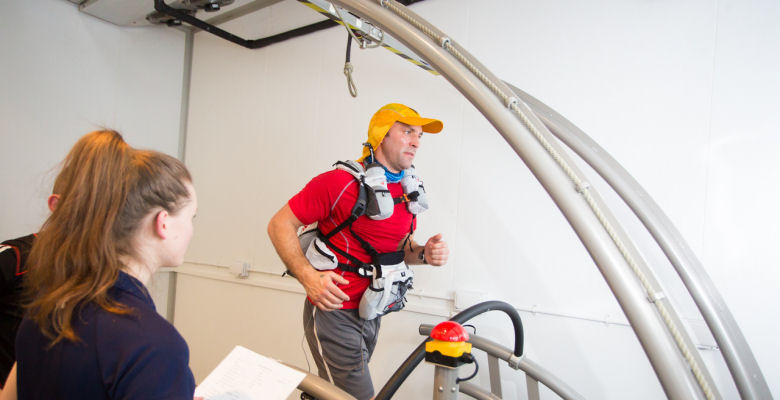Acclimate athletes for exercise challenges

Imagine if you could create the searing heat of the Sahara or the icy cold of the frozen Arctic with the flick of a switch or the press of a button. Sport Scientists at LJMU have done just that with their environmental chambers. This means that they can acclimatise people to extreme changes in temperature under safe, controlled conditions.
Senior Lecturer in Chronobiology and Environmental Physiology Dr Ben Edwards, worked with a team of undergraduate and postgraduate students to train a number of competitors for the Sultan Marathon De Sables, dubbed the hardest race on earth. This race sees competitors cover the equivalent of over five and a half marathons in five or six days, a total distance of around 251 km – 156 miles through the Sahara Desert.
In order for the participants to be ready for this gruelling challenge, in one of the world’s most inhospitable climates, they need to be set up for this environment and that is where the LJMU Sport and Exercise Sciences’ environmental chambers come into play.
Dr Ben Edwards, who has a wealth of knowledge in the area, has worked and competed in Jungle, Desert, Mountain and Arctic environments, explained:
“The rules of the competition require you to be self-sufficient, to carry with you on your back everything except water that you need to survive. You are given a place in a tent to sleep at night, but any other equipment and food must be carried. This self-sufficiency means that anyone taking part must be fully prepared. Exercise, especially in the heat places stress upon body temperature and blood pressure, therefore core temperature needs to be regulated within relatively narrow limits.
“Most of my job as an environmental physiologist involves ‘damage limitation’ for competitors and in our chambers we expose the competitors to a hot environment, and progressively over a period of weeks increase the stress of the environment (increase temperature), the speed they are running at and the weight in their backpacks until they can run at their all-day pace speed on the treadmill with the full kit they are to take on the event in the environmental temperatures they may be exposed to. During their time in the labs they practice and modify the kit they wish to use for the race and practice hydration strategies. To effectively measure adaption we continuously measure rectal temperature and if the runners reach a critical threshold where core temperature values are too high we remove them from the environment and cool them down.”
Postgraduate Sport and Exercise Science students such as Daniel Hill work on measuring sweat rate, urine osmolality and core temperature as the athletes train. He commented on how taking part in this work helps to improve his sport science knowledge:
“Acclimation sessions should be a key component of training for anyone looking to compete in such an extreme event, and volunteering to work with the athletes allows us to gain invaluable practical experience using techniques underpinned by scientific research undertaken by academics such as Dr Ben Edwards. It also serves as a useful personal development opportunity giving me applied experience whilst preparing for a PhD in this field.”
The Tom Reilly Building, where LJMU’s environmental chambers can be located, contains world-class laboratories that facilitate the delivery of a research informed curriculum alongside the development of high quality applied and theory enhancing research. This building, where the School of Sport and Exercise Sciences are based, is named after the late Professor Tom Reilly. Tom completed the first ever PhD in Sport Science in 1975. Tom’s PhD was supervised by Dr Vaughan Thomas, the founding father of Sport Science and the original programme leader back in 1975. Tom has subsequently been credited as the person responsible for forging the rich heritage of Sport and Exercise scientific study at Liverpool Polytechnic, LJMU and beyond.
Dr Edwards, who completed his PhD under Professor Reilly, continued:
“We recruit undergraduates as well as postgraduate students to the ‘team’ to service the athletes; and the students get to apply their theoretical knowledge of physiology to safely adjust the runners to exercising in the heat – we have only had one negative comment over the 15 years I have been doing this work; in 2009 there was a flash flood in the desert and the athletes complained (jokingly) we did not prepare them to swim in the desert.”


